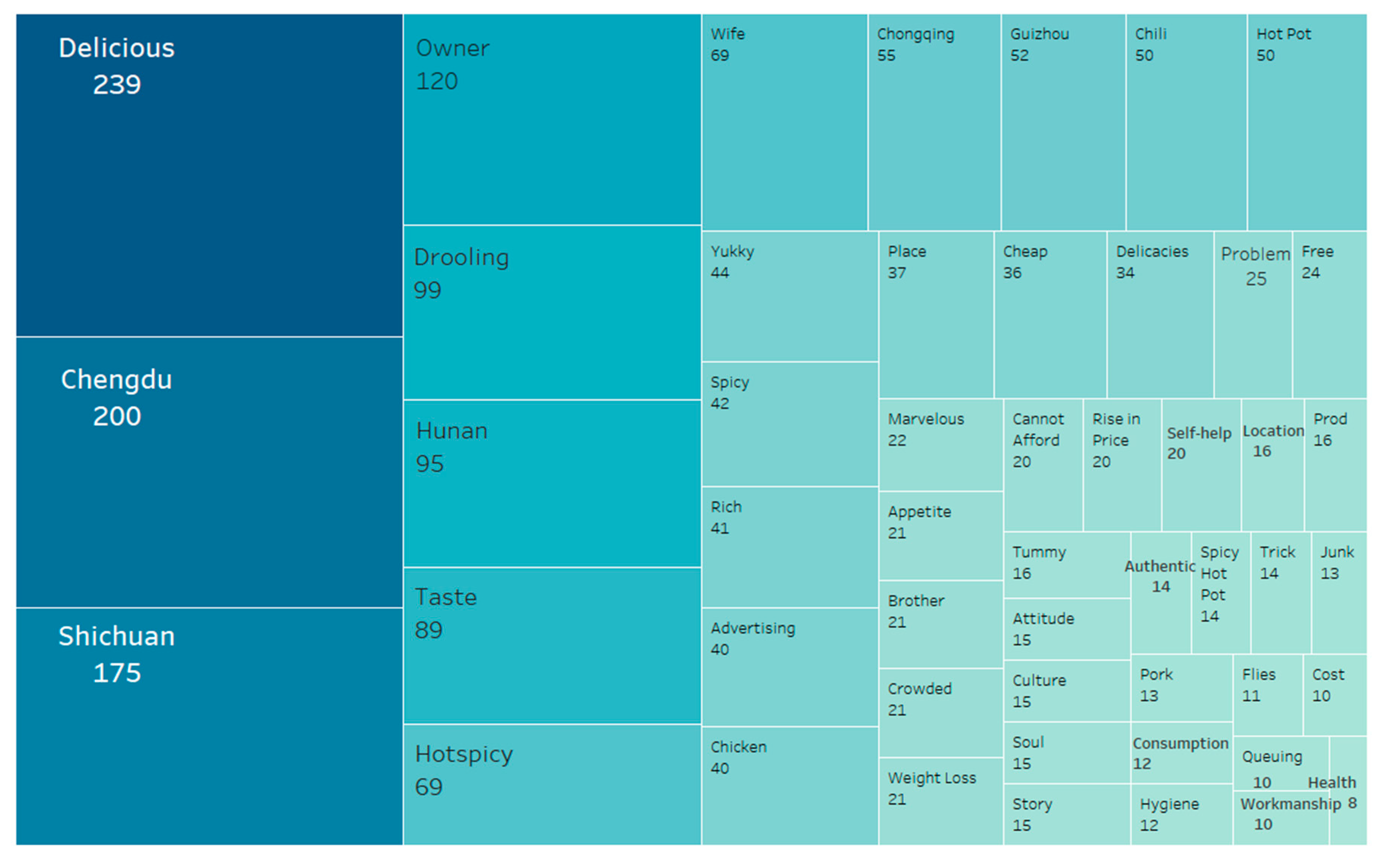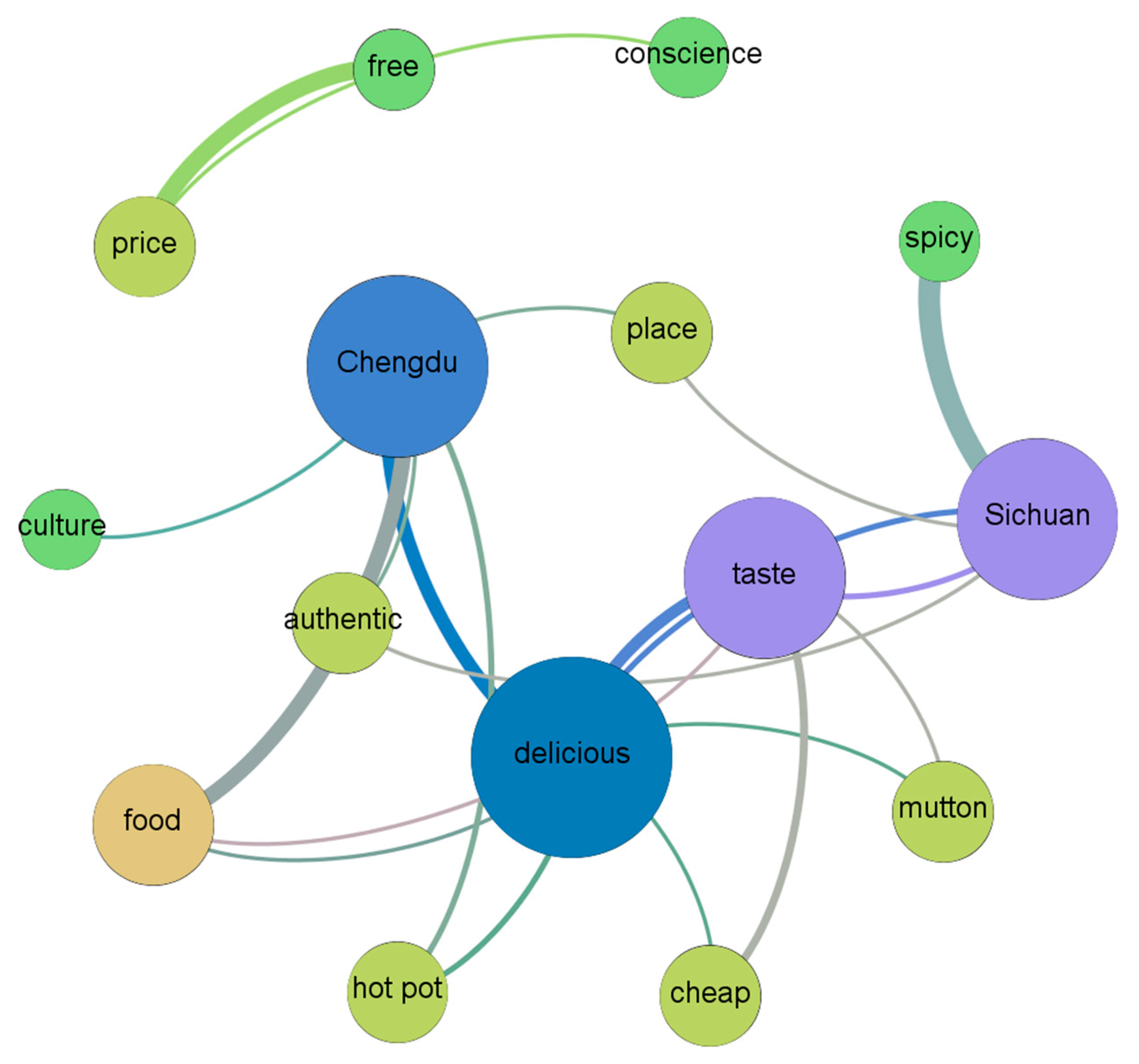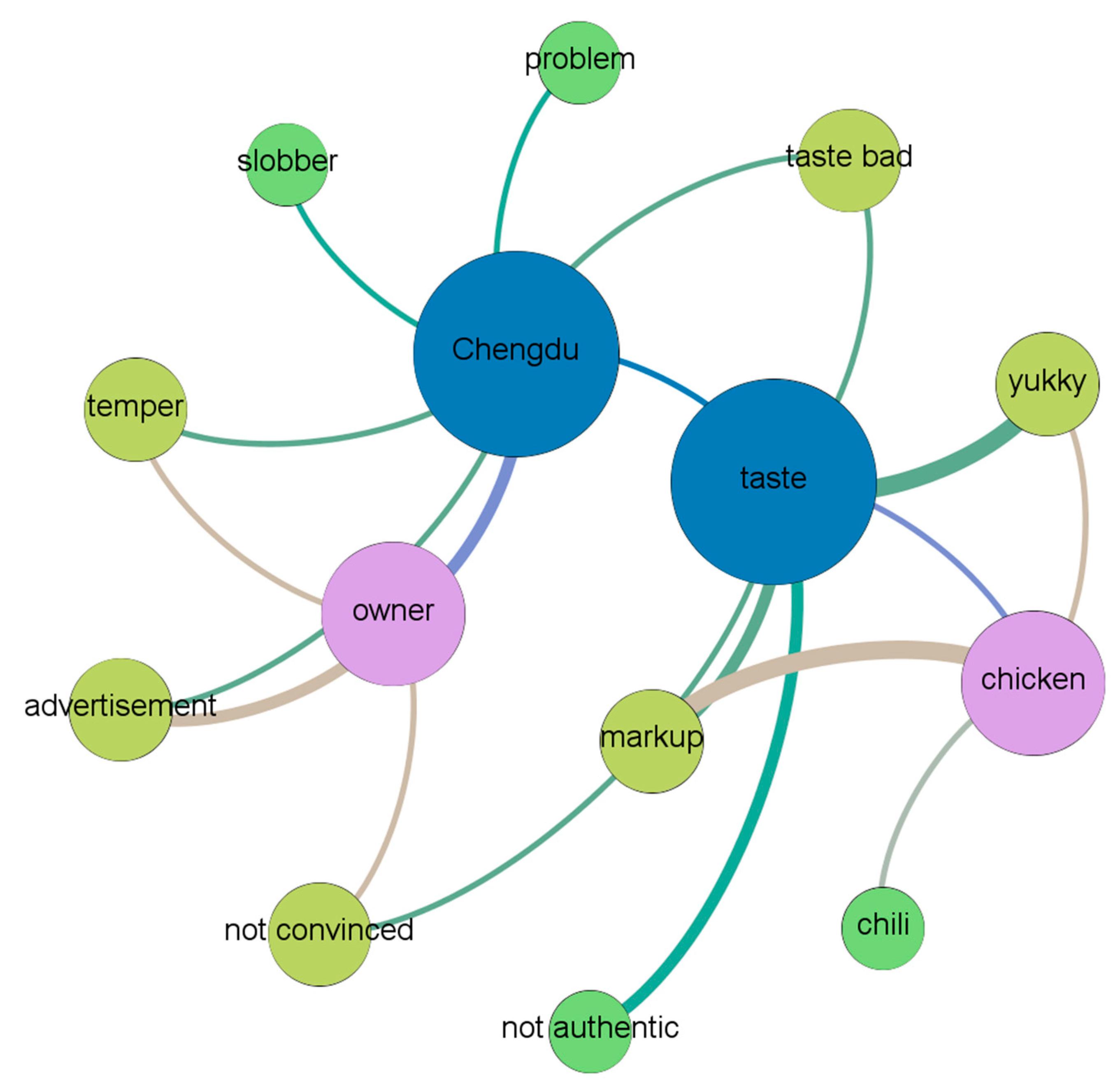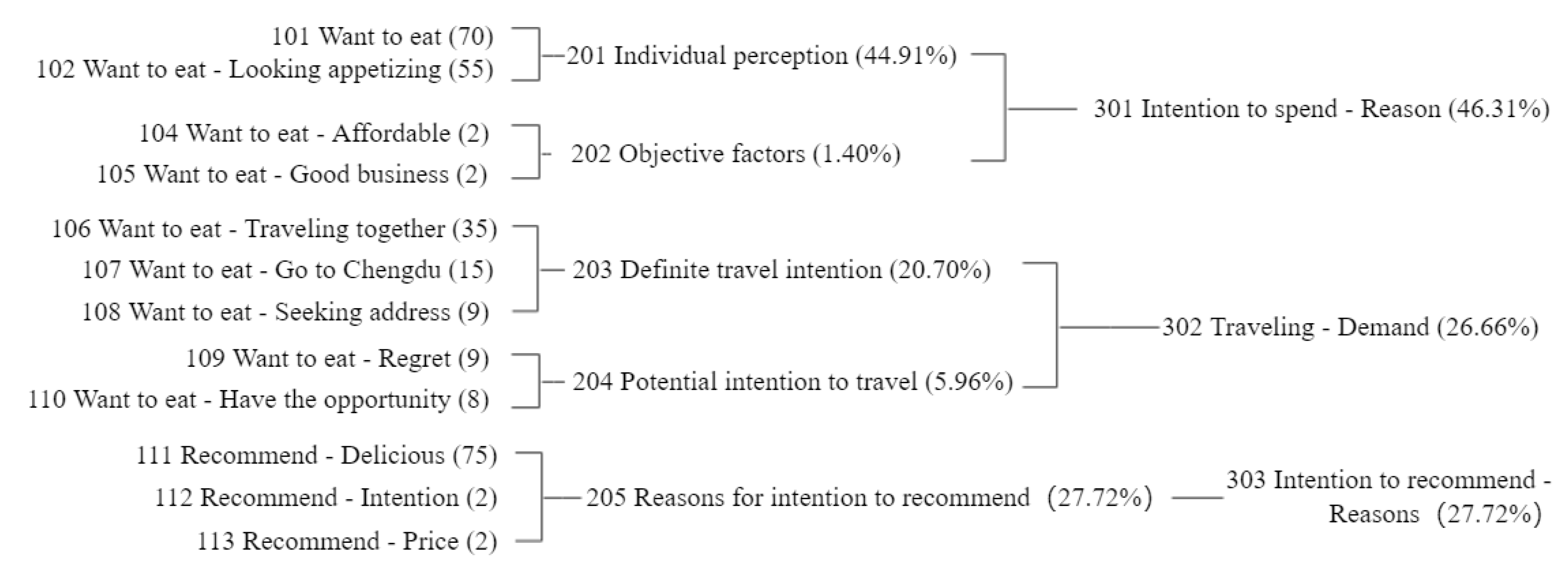Impact of Short Food Videos on the Tourist Destination Image—Take Chengdu as an Example
Abstract
1. Introduction
2. Literature Review
2.1. Destination Image
2.2. Food Image and Branding
2.3. User-Generated Content and Short Video
3. Methodologies
3.1. Content Analysis Methodology
3.2. Sample Selection
4. Results
4.1. Analysis of Cognitive Image
4.2. Analysis of Affective Image
4.3. Analysis of Conative Image
5. Discussion and Conclusions
5.1. Theoretical Implications
- (1)
- This paper analyzes the image of destination conveyed to users by food content in social media. In the previous literature [11,12] on food experience and destination image, the research object only included the tourists who have been to the destination. Our research object of this paper also included a large number of potential tourists who have not been to the destination. The paper explores the impact of short food videos on the tourist destination image, including the cognitive image, affective image and conative image, based on food videos. In terms of cognitive image, we found that short food videos can not only arouse users’ attention to the flavor characteristics of food, but also cause the attention to the local social environment, which indicates that it is possible to convey the image of destination to potential tourists through food content in social media, which influences their travel decisions. In terms of affective image, this paper finds that flavor characteristics and local social environment are more likely to affect the affective image of destination compared with the other four dimensions of food cognitive image. This result supports the previous literature’s conclusion that there is an emotional connection between food and destination [40]. In addition, this paper also makes a more detailed discussion of these affective connections based on the different dimensions of the cognitive image of food. In terms of conative image, this paper finds that the conative image caused by short food videos includes the willingness to obtain information and the willingness to travel together, which have not been mentioned in the previous literature;
- (2)
- Most of the previous studies [45] used online travel notes and Sina Weibo as Chinese text materials to study the destination image. This paper takes TikTok users’ comments as text materials to explore the role of this new social media in the image management and communication of the tourist destination image. In fact, Sina Weibo only allows 140 characters, similar to Twitter, and such limited availability of information sharing or posting can barely influence destination image formation, particularly on the cognitive side [45]. As a social platform for short videos, TikTok is more targeted in its content dissemination than other social media thanks to its excellent recommendation algorithm. Moreover, TikTok combines audio and video forms, and is more life-oriented, situational and social in content, which seems to be more related to affective factors. As mentioned, the results show that TikTok also has an obvious effect on motion and stimulates the potential demand for tourism. Therefore, this study also contributes to the literature on destination image formation in the context of social media.
5.2. Practical Implications
5.3. Limitations and Future Research
Author Contributions
Funding
Conflicts of Interest
References
- Kim, H.; Stepchenkova, S.; Babalou, V. Branding destination co-creatively: A case study of tourists’ involvement in the naming of a local attraction. Tour. Manag. Perspect. 2018, 28, 189–200. [Google Scholar] [CrossRef]
- Tsai, T.C.; Wang, Y.C. Experiential value in branding food tourism. J. Destin. Mark. Manag. 2016. [Google Scholar] [CrossRef]
- Lai, Y.M.; Khoo-Lattimore, C.; Wang, Y. A perception gap investigation into food and cuisine image attributes for destination branding from the host perspective: The case of Australia. Tour. Manag. 2018, 69, 579–595. [Google Scholar] [CrossRef]
- Stephen, C.; Chris, R. Analyzing the evolution of Singapore’s World Gourmet Summit: An example of gastronomic tourism. Int. J. Hosp. Manag. 2012, 6, 309–318. [Google Scholar] [CrossRef]
- Boyne, S.; Hall, D.; Williams, F. Policy, Support and promotion for food-related tourism initiatives: A marketing approach to regional development. J. Travel Tour. Mark. 2003, 14, 131–154. [Google Scholar] [CrossRef]
- Karim, S.; Long, J. Information Sources on Culinary Tourism for France, Italy and Thailand. Anatolia 2008, 19, 166–171. [Google Scholar] [CrossRef]
- Zhou, L.J.; Wang, T. Social media: A new vehicle for city marketing in China. Cities 2014, 37, 27–32. [Google Scholar] [CrossRef]
- Mergel, I. Building Holistic Evidence for Social Media Impact. Public Adm. Rev. 2017, 77, 489–495. [Google Scholar] [CrossRef]
- CASSDATA.May 2019 Panoramic Short Video Monthly. Cass Data. Available online: https://mp.weixin.qq.com/s/8_VRfhg6sTlfmv-iL8xRFw (accessed on 4 December 2019).
- Li, Z. White Paper on Short Video and Urban Image Research. Today’s headline. Available online: https://www.sohu.com/a/254628329_152615 (accessed on 4 December 2019).
- Hsu, F.C.; Scott, N. Food experience, place attachment, destination image and the role of food-related personality traits. J. Hosp. Tour. Manag. 2020, 44. [Google Scholar] [CrossRef]
- Yu, C.E.; Sun, R.S. The role of Instagram in the UNESCO’s creative city of gastronomy: A case study of Macau. Tour. Manag. 2019, 75, 257–268. [Google Scholar] [CrossRef]
- Choe, J.Y.; Kim, S. Effects of tourists’ local food consumption value on attitude toward local food, food destination image, and behavioral intention. Int. J. Hosp. Manag. 2017, 71, 1–10. [Google Scholar] [CrossRef]
- Wang, R.; Hao, J.X.; Law, R.; Wang, J. Examining destination images from travel blogs: A big data analytical approach using latent Dirichlet allocation. Asia Pac. J. Tour. Res. 2019, 24, 1092–1107. [Google Scholar] [CrossRef]
- Hao, Z.Z. Share the Gaze: Representation of destination image on the Chinese social platform WeChat Moments. J. Travel Tour. Mark. 2018, 35, 726–739. [Google Scholar] [CrossRef]
- Hunt, J.D. Image as a factor in tourism development. J. Travel Res. 1975, 13, 1–7. [Google Scholar] [CrossRef]
- Crompton, J.L. An Assessment of the Image of Mexico as a Vacation Destination and the Influence of Geographical Location Upon That Image. J. Travel Res. 1979, 17, 18–23. [Google Scholar] [CrossRef]
- Fakeye, P.C.; Crompton, J.L. Image Differences between Prospective, First-Time, and Repeat Visitors to the Lower Rio Grande Valley. J. Travel Res. 1991, 30, 10–16. [Google Scholar] [CrossRef]
- Stern, E.; Krakover, S. The formation of a composite urban image. Geogr. Anal. 1993, 25, 130–146. [Google Scholar] [CrossRef]
- Gartner, W.C. Image formation process. J. Travel Tour. Mark. 1993, 2, 191–216. [Google Scholar] [CrossRef]
- Wu, J.F. Jigsaw puzzle of tourism destination image and its evaluation index. J. Shaanxi Norm. Univ. Nat. Sci. Ed. 2014, 42, 85–93. [Google Scholar] [CrossRef]
- Pike, S.; Ryan, C. Destination positioning analysis through a comparison of cognitive, affective, and conative perceptions. J. Travel Res. 2004, 42, 333–342. [Google Scholar] [CrossRef]
- Frias, D.; Rodriguez, M.; Castaeda, J. Internet vs. travel agencies on pre-visit destination image formation: An information processing view. Tour. Manag. 2008, 29, 163–179. [Google Scholar] [CrossRef]
- Beerli, A.; Martín, J.D. Factors influencing destination image. Ann. Tour. Res. 2004, 31, 657–681. [Google Scholar] [CrossRef]
- Beerli, A.; Martin, J. Tourists’ characteristics and the perceived image of tourist destinations: A quantitative analysis—A case study of Lanzarote, Spain. Tour. Manag. 2004, 25, 623–636. [Google Scholar] [CrossRef]
- Guan, X.H.; Li, J.Y.; Xie, L.S. The impact of tourism public service quality on destination image. Tour. Sci. 2015, 29, 27–38. [Google Scholar]
- Tan, W.K.; Wu, C.E. An investigation of the relationships among destination familiarity, destination image and future visit intention. J. Destin. Mark. Manag. 2016, 214–226. [Google Scholar] [CrossRef]
- Zhang, H.M.; Lu, L.; Zhang, J.H. The influence of an analysis of the perceiver distance on tourism destination image: A case study of the perceived image of tourist in five origincities on Zhouzhuang, Suzhou. Hum. Geogr. 2006, 21, 25–30. [Google Scholar]
- Sojung, L.; Bai, B. Influence of popular culture on special interest tourists’ destination image. Tour. Manag. 2016, 52, 161–169. [Google Scholar] [CrossRef]
- Tessitore, T.; Pandelaere, M.; Kerckhove, A.V. The amazing race to India: Prominence in reality television affects destination image and travel intentions. Tour. Manag. 2014, 42, 3–12. [Google Scholar] [CrossRef]
- Kim, J.Y.; Kang, J.H.; Kim, Y.Y. Impact of mega sport events on destination image and country image. Sport Mark. Q. 2014, 23, 161–175. [Google Scholar]
- Kim, S.S.; Morrsion, M.A. Change of images of South Korea among foreign tourists after the 2002 FIFA World Cup. Tour. Manag. 2005, 26, 233–247. [Google Scholar] [CrossRef]
- Stone, M.J.; Migacz, S. The American Culinary Traveler: Profiles, Behaviors, & Attitudes; World Food Travel Association: Portland, OR, USA, 2016. [Google Scholar]
- Peter, B.; Hannele, K. Destination foodscape: A stage for travelers’ food experience. Tour. Manag. 2019, 71, 466–475. [Google Scholar] [CrossRef]
- Chang, R.C.Y.; Mak, A.H.N. Understanding gastronomic image from tourists’ perspective: A repertory grid approach. Tour. Manag. 2018, 68, 89–100. [Google Scholar] [CrossRef]
- Seo, S.; Yun, N.; Kim, O.Y. Destination food image and intention to eat destination foods: A view from Korea. Curr. Issues Tour. 2014, 20, 135–156. [Google Scholar] [CrossRef]
- Stajcic, N. Understanding culture: Food as means of communication. Hemisph. Stud. Cult. Soc. 2013, 28, 77–87. [Google Scholar]
- Hammitt, W.E.; Backlund, E.A.; Bixler, R.D. Place bonding for recreation places: Conceptual and empirical development. Leis. Stud. 2006, 25, 17–41. [Google Scholar] [CrossRef]
- Kivela, J.; Crotts, J.C. Tourism and gastronomy: Gastronomy’s influence on how tourists experience a destination. J. Hosp. Tour. Res. 2006, 30, 354–377. [Google Scholar] [CrossRef]
- Woodside, A.G. A general model of traveler destination choice. J. Travel Res. 1989, 27, 8–14. [Google Scholar] [CrossRef]
- Kim, S.; Choe, J.; Lee, S. Effects of food value video clips on increasing the demand for food tourism: Generation Y versus non-Generation, Y. J. Travel Tour. Mark. 2018, 35, 377–393. [Google Scholar] [CrossRef]
- Madaleno, A.; Eusebio, C.; Varum, C. The promotion of local agro-food products through tourism: A segmentation analysis. Curr. Issues Tour. 2019, 22, 643–663. [Google Scholar] [CrossRef]
- Fatanti, M.N.; Suyadnya, W.I. Beyond User Gaze: How Instagram Creates Tourism Destination Brand? Procedia Soc. Behav. Sci. 2015, 211, 1089–1095. [Google Scholar] [CrossRef]
- O’Reilly, T. What is Web 2.0: Design patterns and business models for the next generation of software. Commun. Strateg. 2005, 1, 17. [Google Scholar]
- Kim, S.E.; Lee, Y.K.; Shin, S.I.; Yang, S.B. Effects of tourism information quality in social media on destination image formation: The case of Sina Weibo. Inf. Manag. 2017, 54, 687–702. [Google Scholar] [CrossRef]
- Nicolau, J.L.; Sharma, A.; Shin, S. The tourism effect of President Trump’s participation on Twitter. Tour. Manag. 2020, 81. [Google Scholar] [CrossRef]
- Afshardoost, M.; Eshaghi, S.M. Destination image and tourist behavioural intentions: A meta-analysis. Tour. Manag. 2020, 81. [Google Scholar] [CrossRef]
- Fu, H.; Ye, B.H.; Xiang, J.Z. Reality TV, audience travel intentions, and destination image. Tour. Manag. 2016, 55, 37–48. [Google Scholar] [CrossRef]
- Spencer, D.M. Effectiveness of intra-destination television advertising of tourist attractions and facilities. J. Destin. Mark. Manag. 2013, 2, 155–164. [Google Scholar] [CrossRef]
- Stemler, S. An overview of content analysis. Pract. Assess. Res. Eval. 2001, 7, 137–146. [Google Scholar] [CrossRef]
- Zhao, Y.; Cheng, S.; Yu, X.; Xu, H. Chinese Public’s Attention to the COVID-19 Epidemic on Social Media: Observational Descriptive Study. J. Med. Internet Res. 2020, 22. [Google Scholar] [CrossRef]
- Liu, Y.; Dong, E.; Li, S.; Jie, X. Cruise Tourism for Sustainability: An Exploration of Value Chain in Shenzhen Shekou Port. Sustainability 2020, 12, 54. [Google Scholar] [CrossRef]
- Zhang, H.; Deng, T.; Wang, M.; Chen, X. Content Analysis of Talent Policy on Promoting Sustainable Development of Talent: Taking Sichuan Province as an Example. Sustainability 2019, 11, 2508. [Google Scholar] [CrossRef]
- Shi, K.; Zhang, Y.; Liu, Y. Study on Tourists’ Perception of the Grand Canal Cultural Heritage Based on Network Travels. In Proceedings of the 2019 IEEE Fifth International Conference on Big Data Computing Service and Applications (BigDataService), Newark, CA, USA, 4–9 April 2019; pp. 79–82. [Google Scholar]





| Category | High-Frequency Words | Frequency |
|---|---|---|
| Local Social Environment | Chengdu/Sichuan/Hunan/Wife/Chongqing/ Guizhou/Brother/Story/Soul/Culture | 654 |
| Flavor Characteristics | Delicious/Drooling/Taste/Yucky/ Spicy/Delicacies/Authentic | 561 |
| Restaurant Facilities and Services | Owner/Place/Marvelous/Crowded/Location/ Attitude/Trick/Advertising/Workmanship/Queuing | 305 |
| Local Features | Hotspicy/Chili/Hot Pot/Chicken/Self-help/Spicy Hot Pot/Pork | 256 |
| Price | Rich/Cheap/Free/Rise in Price/Cannot Afford/Consumption/Cost | 163 |
| Health and Safety | Weight Loss/Appetite/Prod/Rummy/Junk/Problem/Flies/Health | 131 |
| Category of Emotion | Number of Comments | Proportion | Intensity | Number of Comments | Proportion |
|---|---|---|---|---|---|
| Positive Emotions (5, +∞) | 1498 | 27.07% | High (25, +∞) | 123 | 2.22% |
| Moderate (15, 25) | 275 | 4.97% | |||
| General (5, 15] | 1100 | 19.88% | |||
| Neutral Emotions [−5, 5] | 3290 | 59.45% | |||
| Negative Emotions (−∞, −5) | 746 | 13.48% | High (−∞, −25) | 26 | 0.47% |
| Moderate [−25, −15) | 81 | 1.46% | |||
| General [−15, −5) | 639 | 11.55% |
© 2020 by the authors. Licensee MDPI, Basel, Switzerland. This article is an open access article distributed under the terms and conditions of the Creative Commons Attribution (CC BY) license (http://creativecommons.org/licenses/by/4.0/).
Share and Cite
Li, Y.; Xu, X.; Song, B.; He, H. Impact of Short Food Videos on the Tourist Destination Image—Take Chengdu as an Example. Sustainability 2020, 12, 6739. https://doi.org/10.3390/su12176739
Li Y, Xu X, Song B, He H. Impact of Short Food Videos on the Tourist Destination Image—Take Chengdu as an Example. Sustainability. 2020; 12(17):6739. https://doi.org/10.3390/su12176739
Chicago/Turabian StyleLi, Yi, Xiuxiu Xu, Bo Song, and Hong He. 2020. "Impact of Short Food Videos on the Tourist Destination Image—Take Chengdu as an Example" Sustainability 12, no. 17: 6739. https://doi.org/10.3390/su12176739
APA StyleLi, Y., Xu, X., Song, B., & He, H. (2020). Impact of Short Food Videos on the Tourist Destination Image—Take Chengdu as an Example. Sustainability, 12(17), 6739. https://doi.org/10.3390/su12176739





